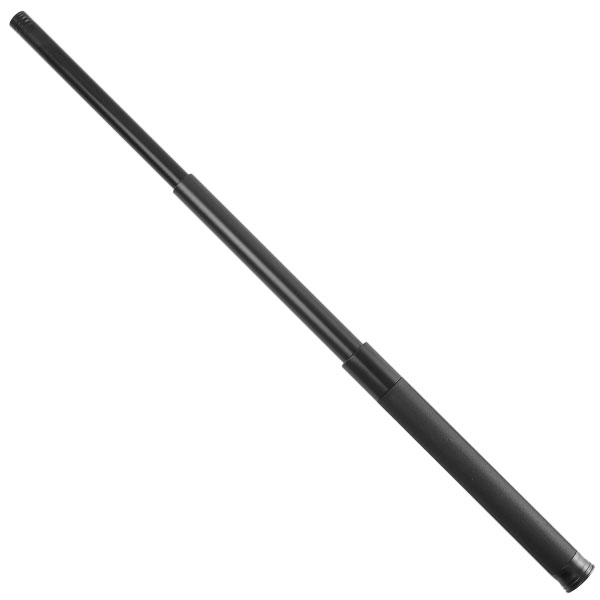
When you face a threatening situation, having a push-button baton by your side doesn’t just offer reassurance—it provides an effective means of defense. Its quick deployment mechanism is invaluable, allowing for an immediate response when every second counts.
But it’s not just about having the tool but mastering its use. Every aspect requires practice and understanding, from the essential grip and stance to precise strikes at targeted areas.
As we explore defensive maneuvers and the legal considerations surrounding self-defense tools, you’ll discover how to integrate a baton seamlessly into your safety routine. Stick around to uncover key strategies that could make all the difference.
Push-button batons, which feature a quick deployment mechanism, offer a compact and effective self-defense tool that can be easily extended to full length with just a button press. These expandable batons are designed with your safety in mind, allowing for rapid deployment in situations where every second counts.

Unlike some traditional self-defense batons, push-button batons can be activated and ready to use instantly, thanks to their one-handed operation. This feature is essential in high-stress scenarios where you might not have the luxury of using both hands.
Compact and easy to carry and conceal, push-button batons are an excellent choice for law enforcement and civilians. Their ease of use and effectiveness have contributed to their popularity. You don’t need to be an expert to operate one effectively; the simple mechanism does the hard work for you, expanding the baton to its full size with minimal effort on your part.
This user-friendly design ensures you’re always prepared, whether walking home late at night or facing an unexpected security challenge.
Let’s focus on mastering the right grip and stance techniques for effective self-defense when using push-button batons.
First, maintain a firm grip on your push-button baton. This ensures complete control and stability, which is crucial in self-defense. Practice different grip variations to adapt to various scenarios easily. Keeping the baton close to your body enhances maneuverability and allows for quick deployment when necessary.

Now, let’s discuss the stance. A balanced and stable stance is not just beneficial; it’s essential. It maximizes striking power and strengthens defensive capabilities. Picture yourself as a tree with deep roots, seeking that solid foundation that enables you to move, strike, or defend with power and precision.
Mastering proper grip and stance techniques is foundational to effectively using your push button baton. It’s all about ensuring precision and efficiency in defensive tactics and strikes. Dedicate time to practicing these basics; you’ll feel more confident and prepared in any self-defense situation.
To maximize your push button baton’s defensive capabilities, it’s crucial to identify the right target areas and execute effective strikes. Focusing on muscle groups like the arms, legs, and torso can help control and incapacitate an assailant. Targeting joints such as knees, elbows, and wrists is key for a quicker disablement. A well-placed strike in these areas can limit the attacker’s mobility without causing excessive harm.
Regular practice is essential. Make sure to work on hitting these specific areas with precision and control, preferably on training dummies. This practice sharpens your accuracy and helps you gauge the necessary force without going overboard. Remember, the aim is to defend yourself, not to inflict unnecessary harm.
Using controlled force when striking is important, especially on vulnerable points. This ensures that you are within the realm of self-defense and avoid legal and moral implications. Mastering these effective strikes and a solid defensive posture can significantly boost your self-defense abilities, enabling you to respond confidently and efficiently in any situation.
To effectively protect yourself against incoming attacks, regularly practicing defensive maneuvers with your push-button baton is important. You should learn to use the baton as an extension of your arm, not just for striking but also for blocking and deflecting strikes. This means being quick and responsive, moving the baton to intercept an attacker’s blows to prevent them from landing.
Mastering techniques for safely disarming opponents is also crucial. Your push-button baton can be a powerful tool in self-defense scenarios if you know how to use it to neutralize a threat without unnecessarily escalating the situation. It’s about control, not just force.
Furthermore, combining baton strikes with other defensive tactics enhances your overall defense strategy. Consider incorporating movements that help you keep a safe distance from an attacker or utilize your surroundings to your advantage.
It’s not just about the baton; it’s about how you use it in conjunction with your body and surroundings to stay safe.
Before you use your push-button baton for self-defense, it’s crucial to know the local laws and regulations. This way, you can avoid legal issues. Understanding these rules keeps you on the right side of the law and shields you if you must explain your actions.
Let’s explore the key legal and ethical considerations:
To become proficient in using your push-button baton, you must practice consistently to master various grips, stances, and defensive techniques. Familiarizing yourself with different ways to hold and position your baton will help ensure peak control and stability. Developing this foundation is crucial for executing powerful and precise strikes.

Repetitive training that focuses on target areas will improve your accuracy and effectiveness. It’s not just about hitting hard but hitting correctly. Practice your swings, aiming for specific points to simulate real self-defense scenarios. Incorporating defensive tactics like blocking and disarming into your routine will also enhance your overall defense capabilities. Remember, it’s all about combining speed, power, and technique.
Understanding the legal considerations and proper use of force with your baton is vital. This knowledge ensures that you are effective and responsible in its deployment. Record your training sessions, noting improvements and areas that need work. Reflecting on your practice will help you track your progress and adjust your routine for continuous development.
Mastering the art of self-defense with a push-button baton requires dedication. You can enhance your skills and be prepared for any situation with the right practice routines.
Yes, a baton is good for self-defense. It’s portable, has good reach, and offers a less-lethal option. However, you’ll need proper training to use it effectively and to understand the legal considerations.
The best length baton for self-defense typically ranges from 16 to 26 inches. Considering your height and comfort, you’ll want to balance reach and control. It’s about what feels right for your specific needs.
In San Diego, a federal judge has reversed a California law banning club-like weapons. This ruling represents a shift from his earlier decision in 2021 when he had upheld the prohibition on billy clubs, batons, and similar blunt items with reluctance.
Pepper Spray Wholesale provides non-lethal self defense products and hidden cameras for you, your loved ones and your home. If you have any questions about the products, do not hesitate to Contact Us. Stay Safe!
Pepper Spray Wholesale
1867 Caravan Trail
Ste 105
Jacksonville, FL 32216
Call us toll free: (800) 859-5566